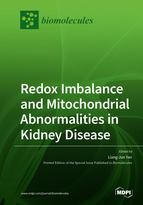Redox Imbalance and Mitochondrial Abnormalities in Kidney Disease
A special issue of Biomolecules (ISSN 2218-273X). This special issue belongs to the section "Molecular Medicine".
Deadline for manuscript submissions: closed (15 December 2021) | Viewed by 47192
Special Issue Editor
Interests: redox imbalance; oxidative stress; neuroprotection; diabetes; mitochondrial dysfunction; protein oxidation
Special Issues, Collections and Topics in MDPI journals
Special Issue Information
Dear Colleagues,
The kidney performs important functions in our body and can inflict either acute kidney injury (AKI) or chronic kidney disease (CKD). AKI could be induced by kidney ischemia, by drugs such as cisplatin, and by heavy metals such as cadmium and arsenic. CKD could be induced by drugs, heavy metals, hypertension and diabetes as well as cancer. Importantly, nearly all kidney disorders have been shown to involve redox imbalance, reductive stress, oxidative stress, and mitochondrial abnormalities such as impaired mitochondrial homeostasis, including disrupted mitophagy and deranged mitochondrial unfolded protein response. Understanding how these redox-related dysregulated pathways may give us new insights into how to design novel approaches to fighting kidney disease.
This Special Issue will cover all topics related to AKI and CKD and will especially welcome submissions of manuscripts on redox mechanisms and pathophysiology underlying diabetic nephropathy or diabetic kidney disease (DKD) using all kinds of diabetic animal models. It should be noted that this Special Issue will consider publication of both review articles and original research articles.
Dr. Liang-Jun Yan
Guest Editor
Manuscript Submission Information
Manuscripts should be submitted online at www.mdpi.com by registering and logging in to this website. Once you are registered, click here to go to the submission form. Manuscripts can be submitted until the deadline. All submissions that pass pre-check are peer-reviewed. Accepted papers will be published continuously in the journal (as soon as accepted) and will be listed together on the special issue website. Research articles, review articles as well as short communications are invited. For planned papers, a title and short abstract (about 100 words) can be sent to the Editorial Office for announcement on this website.
Submitted manuscripts should not have been published previously, nor be under consideration for publication elsewhere (except conference proceedings papers). All manuscripts are thoroughly refereed through a single-blind peer-review process. A guide for authors and other relevant information for submission of manuscripts is available on the Instructions for Authors page. Biomolecules is an international peer-reviewed open access monthly journal published by MDPI.
Please visit the Instructions for Authors page before submitting a manuscript. The Article Processing Charge (APC) for publication in this open access journal is 2700 CHF (Swiss Francs). Submitted papers should be well formatted and use good English. Authors may use MDPI's English editing service prior to publication or during author revisions.
Keywords
- acute kidney injury
- chronic kidney disease
- diabetic nephropathy
- diabetic kidney disease
- redox imbalance
- reductive stress
- reactive oxygen species
- oxidative stress
- mitochondrial abnormalities
- mitochondrial homeostasis
- mitophagy
- unfolded protein response







